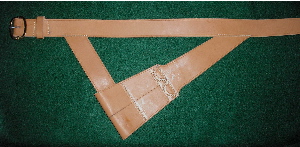Quick summary:
- How was the small sword (or dress sword) fastened to the body?
- What are the different ways of wearing it?
Looking at many drawings from this period, a good bunch of them depicts men with small swords. But it is hard to notice how the sword was connected to their body. There usually is no belt (let alone a duty belt). See for example here or here. Next, probably two connections are needed to make the blade have a nice 45° angle.
IF a belt was used under the waistcoat, why was it worn under and not over the waistcoat? People in those times surely could create nice belts with nice buckles to give a great overall picture.
Most notably from the first picture: The sword is really more on the back than on the side. So this seems to be more ceremonial, because it would have taken much too long to take the sword. On the other drawing we see it more on the side. So how did people decide where to put it?
I assume, that for the side option, the longer part of the blade was somewhere in the frills of the justaucorps. While for the back option, it goes through the cut in the back?
Have people in those times used different angles for the sword? Like more downward, so that one could navigate easier in larger crowds?
Update
The way of wearing the sword surely evolved over time and possibly changed within or before/after the 18th century. Answers are allowed and even encouraged to put things into their appropiate context and include such info.
One comment suggests, that this question is a red herring and there are way too many ways of wearing the small sword.
First: I thihk, there were rules on this. At those times, there were many rules for etiquette like things (like how to lift your tricorne). There were also rules on when not to wear the small sword, etc. So I doubt that there were no rules on how to wear it.
Second: Assuming there were a lot of variants (I can imagine that things changed over time), then a good answer could reference some more common forms and give some evidence on not so common ones or the like.


